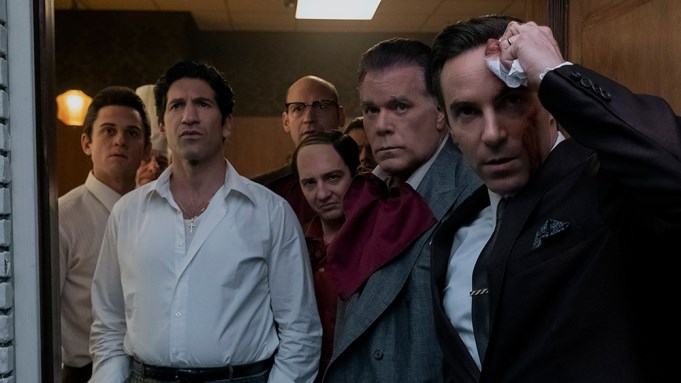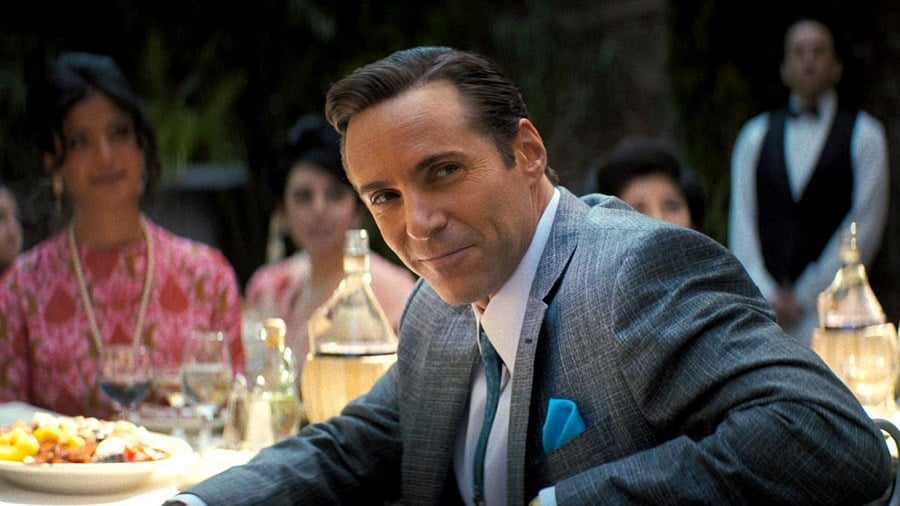Narrated from beyond the grave, David Chase’s feature prequel to The Sopranos ranks among the better film adaptations of popular TV series.

Let’s begin, as David Chase’s The Many Saints of Newark does, with a spoiler. You don’t have to have seen The Sopranos to enjoy the new film, but if you are watching it at the moment make sure you finish the series before reading this.
A camera creeps through a cemetery in New Jersey. As it passes gravestones, we hear the voices of the dead, records of a city’s past; we’re like the angels in Wim Wenders’ Wings of Desire (1987), privy to the thoughts of Berlin’s populace. It stops at the grave of Christopher Moltisanti and the voice of Michael Imperioli, the only actor from the original TV series present in the film, introduces us to this world.

The Many Saints of Newark (2021)
It’s the late 1960s, Christopher has yet to be born. Tony Soprano, the future boss who will one day kill Christopher, is a young boy. For now, the local underworld is overseen by Tony’s father Johnny Boy (John Bernthal), his uncle Junior (Corey Stoll) and Christopher’s father Dickie (Alessandro Nivola). The action begins as Dickie’s corpulent, boorish father Aldo ‘Hollywood Dick’ Moltisanti (Ray Liotta) returns home from Italy, accompanied by his new wife Joanna (Gabriella Piazza). The look she exchanges with the handsome Dickie as they meet spells trouble.

The Many Saints of Newark (2021)
Chase, who wrote and produced the film, entrusted the directing to his Sopranos regular Alan Taylor. But to all intents and purposes, this is a David Chase film. And as with his TV series, he eschews driving narrative in favour of character development. To watch The Many Saints of Newark without having seen the series that preceded it does miss out on the pleasure to be had watching younger actors play the better known older versions of themselves. So, even if Billy Magnussen doesn’t look like the older Paulie (Tony Sirico) his mannerisms – fussy and garrulous – immediately identify him. Silvio (John Magaro, a dramatic transformation from his pastry chef in Kelly Reichardt’s First Cow) is just as grumpy and hunched as his older self (Steven Van Zandt), while Mattea Conforti and Alexandra Intrator channel Aida Turturro’s Janice Soprano to an uncanny degree. Topping them all is Corey Stoll’s superb take on Dominic Chianese’s Junior, his malevolence hidden behind a seemingly innocuous appearance. And Vera Farmiga is perfect as the younger version of Nancy Marrchand’s Livia Soprano, Tony’s mother. She conveys the frustrations of being a mobster’s wife and the matriarch in a traditional and conservative Italian American family, eventually fusing into the bane of older Tony’s life.

Much has been written about Michael Gandolfini’s portrayal of his real-life father James in the role of Tony Soprano. If Chase does stick to his plan of making a second film, focusing on Tony’s twenties as he transforms into a mobster, then the young actor will likely have more room to flourish. But here, he plays second fiddle to Dickie, whose life the film orbits. Alessandro Nivola doesn’t have the pressure of recreating a character from the series and so he fully embraces the freedom to develop his role. It’s a superb performance, shifting gear in every scene, conveying Dickie’s charm and generosity which, in a hair’s breadth, can turn to rage. His actions weigh heavily on him and his guilt over the things he has done eventually affect the one true, untainted friendship he has, with the young Tony. It’s through Dickie that Chase also expands this world beyond the clan of Italian American mobsters. More aware than the other hoods of the changes taking place in the US at the time, Dickie forges a loose alliance with Black gangster Harold McBrayer (Leslie Odom Jr.). It allows Chase an alternative perspective on the 1967 Newark Riots, started as a result of police intimidation. It also brings the legendary Frank Lucas into the narrative, whose story was told in Ridley Scott’s American Gangster (2007), with Denzel Washington playing the renowned Harlem drug lord.

The Many Saints of Newark (2021)
Female characters play a less prominent role in the film than they did in series. The film’s limited running time may have been a factor, but the decision feels more a reflection of the roles women occupied in this era compared to thirty years later. (Edie Falco did shoot a scene for the beginning of the film, but it was eventually left out of the final cut.) Again, it will be interesting to see how this aspect shifts if the second film is made.
The Many Saints of Newark arrives some 14 years after the polarising final episode of The Sopranos first aired. The series is credited with starting a golden age in television. The quality of its writing, the faith it had in its audience’s intelligence, its play with narrative structure and conventions, and its overall playfulness – it was bold enough to deconstruct screen representations of Italian Americans, with characters discussing the cliches of movie and TV gangsters, at the same time that it was indulging in them – set a high benchmark that subsequent series aspired to. Game of Thrones might be celebrated for its willingness to despatch lead characters at the drop of a hat. But The Sopranos did it first. There was Pussy (Vincent Pastore), Bobby (Steven R. Schrripa), Tony Blundetto (Steve Buscemi) Ralph (Joe Pantoliano), Richie (David Proval) and Adriana (Drea de Matteo) and Christopher, to name a few. And who knows how the final scene of the last episode would have played out…

The Many Saints of Newark (2021)
The film follows in the tradition of countless TV series that have moved to the big screen. More often than not, the move was seen as a potentially lucrative commercial decision – a way for a studio to extract more revenue from a popular show. The results have varied. For every success, such as The Fugitive (1993), 21 Jump Street (2012), The Untouchables (1987), The Naked Gun: From the Files of Police Squad! (1988) and some of the Mission: Impossible and Star Trek entries, there was Lost in Space (1998), Starsky & Hutch (2004), Bewitched (2005) and, at the lowest end, the two Sex in the City films. (There’s also the middle ground, where films such as Michael Mann’s 2006 divisive, big screen adaptation of his Miami Vice series exist.)

The Many Saints of Newark (2021)
If Chase’s and HBO’s intention was to cash in on the success of The Sopranos, The Many Saints of Newark would have appeared over a decade ago. The film is too crafted to be little more than a money spinner. And it is more than an appendage to a beloved show in the way that Vince Gilligan’s enjoyable but superfluous El Camino: A Breaking Bad Movie – or what happened to Jesse Pinkman following his narrow escape at the end of series five – turned out to be. That Chase has stated his intention to return to Tony Soprano’s story with a new film, linking the narrative of The Many Saints of Newark more firmly with the storylines that grew out of The Sopranos, makes sense. And with it he will expand on a saga that is less a portrait of the American Dream turned sour than an intricately crafted family tree of American life and aspirations, which every now and again requires a few of its branches to be cut.
The Many Saints of Newark is still showing in cinemas

